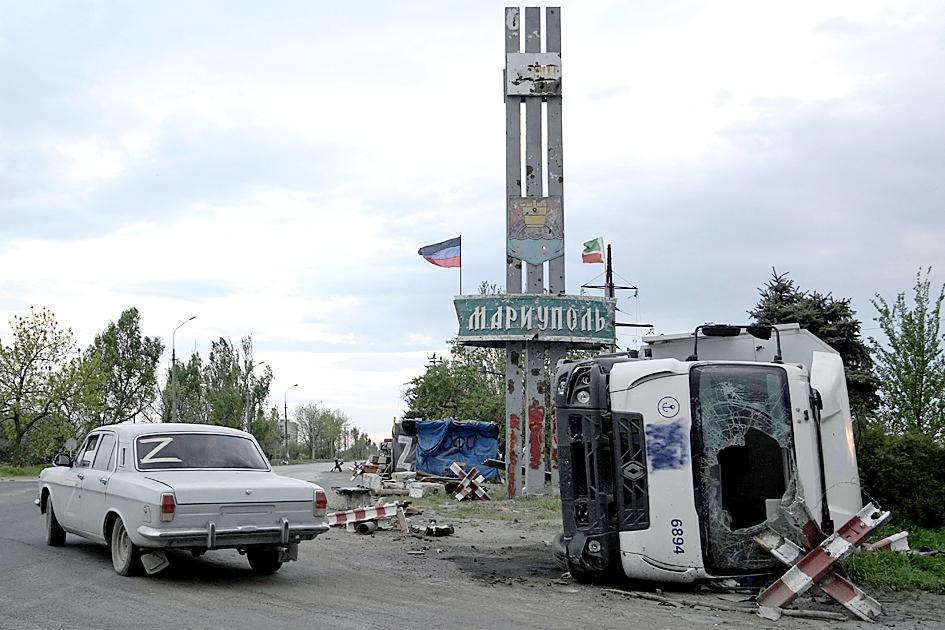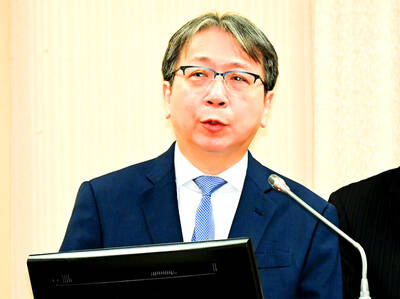AFP, KYIV
Kyiv yesterday said that more than 1,000 Ukrainian troops, many of them injured, remained in the sprawling Azovstal steel works in the Russian-controlled port city of Mariupol.
“More than a thousand” Ukrainian soldiers remain in the plant, Deputy Prime Minister Iryna Vereshchuk, said. “Hundreds are injured. There are people with serious injuries who require urgent evacuation.”

Photo: AFP
Earlier yesterday, Matilda Bogner, head of the UN Human Rights Monitoring Mission in Ukraine, told reporters in Geneva, Switzerland, that since the Russian invasion, thousands more civilians have been killed than the official UN death toll of 3,381.
The UN team, which includes 55 monitors in Ukraine, has said that most of the deaths occurred from the use of explosive weapons with a wide impact area, such as shelling and airstrikes.
“We have been working on estimates, but all I can say for now is that it is thousands higher than the numbers we have currently given to you,” Bogner said.
“The big black hole is Mariupol, where it has been difficult for us to fully access and to get fully corroborated information,” she said.
On Monday, Ukraine’s Black Sea port of Odesa came under repeated missile attack.
The Ukrainian military said that Russian forces fired seven missiles from the air at Odesa, hitting a shopping center and a warehouse.
As part of the barrage, a Russian supersonic bomber fired three hypersonic missiles, said the Center for Defense Strategies, a Ukrainian think tank tracking the war.
Using advanced guided missiles allows Russia to fire from aircraft at a distance, without being exposed to potential anti-aircraft fire.
Meanwhile, US President Joe Biden signed a law speeding up arms deliveries to Kyiv.
The US has sent about US$4 billion in military aid to Ukraine, but “caving to aggression is even more costly,” Biden said.
In a bid to build pressure on Russia, European Commission President Ursula von der Leyen said she made “progress” on a proposed Russian oil embargo during talks with Hungarian Prime Minister Viktor Orban.
Additional reporting by Reuters, AP

The US government has signed defense cooperation agreements with Japan and the Philippines to boost the deterrence capabilities of countries in the first island chain, a report by the National Security Bureau (NSB) showed. The main countries on the first island chain include the two nations and Taiwan. The bureau is to present the report at a meeting of the legislature’s Foreign Affairs and National Defense Committee tomorrow. The US military has deployed Typhon missile systems to Japan’s Yamaguchi Prefecture and Zambales province in the Philippines during their joint military exercises. It has also installed NMESIS anti-ship systems in Japan’s Okinawa

TRAGEDY STRIKES TAIPEI: The suspect died after falling off a building after he threw smoke grenades into Taipei Main Station and went on a killing spree in Zhongshan A 27-year-old suspect allegedly threw smoke grenades in Taipei Main Station and then proceeded to Zhongshan MRT Station in a random killing spree that resulted in the death of the suspect and two other civilians, and seven injured, including one in critical condition, as of press time last night. The suspect, identified as a man surnamed Chang Wen (張文), allegedly began the attack at Taipei Main Station, the Taipei Fire Department said, adding that it received a report at 5:24pm that smoke grenades had been thrown in the station. One man in his 50s was rushed to hospital after a cardiac arrest

‘WIN-WIN’: The Philippines, and central and eastern European countries are important potential drone cooperation partners, Minister of Foreign Affairs Lin Chia-lung said Minister of Foreign Affairs Lin Chia-lung (林佳龍) in an interview published yesterday confirmed that there are joint ventures between Taiwan and Poland in the drone industry. Lin made the remark in an exclusive interview with the Chinese-language Liberty Times (the Taipei Times’ sister paper). The government-backed Taiwan Excellence Drone International Business Opportunities Alliance and the Polish Chamber of Unmanned Systems on Wednesday last week signed a memorandum of understanding in Poland to develop a “non-China” supply chain for drones and work together on key technologies. Asked if Taiwan prioritized Poland among central and eastern European countries in drone collaboration, Lin

ON ALERT: Taiwan’s partners would issue warnings if China attempted to use Interpol to target Taiwanese, and the global body has mechanisms to prevent it, an official said China has stationed two to four people specializing in Taiwan affairs at its embassies in several democratic countries to monitor and harass Taiwanese, actions that the host nations would not tolerate, National Security Bureau (NSB) Director-General Tsai Ming-yen (蔡明彥) said yesterday. Tsai made the comments at a meeting of the legislature’s Foreign Affairs and National Defense Committee, which asked him and Minister of National Defense Wellington Koo (顧立雄) to report on potential conflicts in the Taiwan Strait and military preparedness. Democratic Progressive Party (DPP) Legislator Michelle Lin (林楚茵) expressed concern that Beijing has posted personnel from China’s Taiwan Affairs Office to its